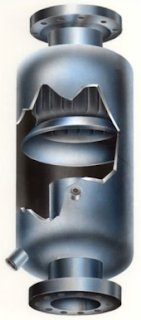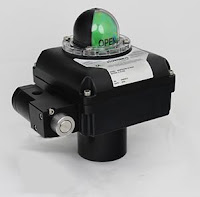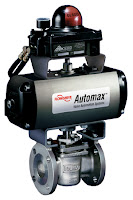May your holidays glitter with unforgettable moments of happiness, laughter, and good cheer.
Providing problem solving and educational information for topics related to industrial steam, hot water systems, industrial valves, valve automation, HVAC, and process automation. Have a question? Give us a call at (800) 892-2769 | www.meadobrien.com
Season's Greetings from Mead O'Brien
A Peek Inside an Industrial Centrifugal Separator
 A centrifugal separator is a piece of equipment that uses centrifugal force, the force of gravity, and inertia to separate two or more materials. Centrifugal separators work by spinning the material in a chamber at high speed which causes the heavier materials to settle out separately from the lighter materials.
A centrifugal separator is a piece of equipment that uses centrifugal force, the force of gravity, and inertia to separate two or more materials. Centrifugal separators work by spinning the material in a chamber at high speed which causes the heavier materials to settle out separately from the lighter materials.Upon entering the spinning chamber of a centrifugal separator, the spinning force affect materials differently. Heavier materials are more affected by gravity, while lighter materials are affected by inertia. As the materials separate, they are collected in various mechanical or physical ways, such as filtering and screening.
Gases can be purified through the spinning process to remove particulate matter and moisture. The pure gas gas is then be collected as it escapes through the top of the centrifugal separator. Similarly liquids of different weights and viscosities are divided into various chambers in the separator as it moves along.
The Anderson Hi-eF™ Centrifugal Separators operate on a patented two-stage principle of separation that employs carefully controlled flow guiding the entrainment laden vapor through a series of vanes and baffles. Each component of the separating element is designed to obtain maximum separating efficiency. Briefly, in the first stage of the separation, impingement against a baffle removes the larger droplets of entrainment. In the second stage of separation, the separator removes the fine mist entrainment by utilizing centrifugal scrubbing action through a uniquely designed contact element. In each stage, the gas medium and the separated liquid are carefully and continuously guided for maximum efficiency. The separators are designed to handle large volume flow of a broad range of fluids. Self-cleaning and engineered without filters or moving parts, the separators are free from maintenance and repair. For more information visit http://www.meadobrien.com or call (800) 892-2769.
Watch this video to see an animation of what happens inside the centrifugal separator.
The Application of Limit Switches on Automated Industrial Valves
 |
| Limit switch with position indicator. |
Employed in a wide range of industrial applications and operating conditions, limit switches
 |
| Automated valve assembly including actuator and limit switch. |
Valves, devices used for controlling flow, are motion based. The movable portions of valve trim create some degree of obstruction to media flow, providing regulation of the passage of the media through the valve. It is the movement of critical valve trim elements that limit switches are used to indicate or control. The movable valve trim elements commonly connect to a shaft or other linkage extending to the exterior of the valve body. Mounting electric, hydraulic, or pneumatic actuators to the shaft or linkage provides the operator a means to drive the mechanical connection, changing the orientation or position of the valve trim and regulating the media flow. Because of its positive connection to the valve trim, the position of the shaft or linkage is analogous to the trim position and can be used to indicate what is commonly referred to as “valve position”. Limit switches are easily applied to the valve shaft or linkage in a manner that can provide information or direct functional response to certain changes in valve position.
In industrial valve terms, a limit switch is a device containing one or more magnetic or electrical switches, operated by the rotational or linear movement of the valve.
What are basic informational elements that can be relayed to the control system by limit switches? Operators of an industrial process, for reasons of efficiency, safety, or coordination with other process steps, may need answers to the following basic questions about a process control valve:
Employing a properly configured valve automation package, with limit switches delivering valve status or position information to your control system, can yield operational and safety benefits for the life of the unit. Good advice is to consult with a valve automation specialist for effective recommendations on configuring your valve automation accessories to maximize the level of information and control.
In industrial valve terms, a limit switch is a device containing one or more magnetic or electrical switches, operated by the rotational or linear movement of the valve.
What are basic informational elements that can be relayed to the control system by limit switches? Operators of an industrial process, for reasons of efficiency, safety, or coordination with other process steps, may need answers to the following basic questions about a process control valve:
- Is the valve open?
- Is the valve closed?
- Is the valve opening position greater than “X”?
- Has the valve actuator properly positioned the valve at or beyond a certain position?
- Has the valve actuator driven the valve mechanism beyond its normal travel limits?
- Is the actuator functioning or failing?
Partial or complete answers to these and other questions, in the form of electrical signals relayed by the limit switch, can serve as confirmation that a control system command has been executed. Such a confirmation signal can be used to trigger the start of the next action in a sequence of process steps or any of countless other useful monitoring and control operations.
Applying limit switches to industrial valve applications should include consideration of:
Applying limit switches to industrial valve applications should include consideration of:
- Information Points – Determine what indications are necessary or useful for the effective control and monitoring of valve operation. What, as an actual or virtual operator, do you want to know about the real time operational status of a valve that is remotely located. Schedule the information points in operational terms, not electrical switch terms.
- Contacts – Plan and layout a schedule of logical switches that will provide the information the operator needs. You may not need a separate switch for each information point. In some cases, it may be possible to derive needed information by using logical combinations of switches utilized for other discrete functions.
- Environment – Accommodate the local conditions and hazards where the switch is installed with a properly rated enclosure.
- Signal – The switch rating for current and voltage must meet or exceed those of the signal being transmitted.
- Duty Cycle – The cycling frequency must be considered when specifying the type of switch employed. Every switch design has a limited cycle life. Make sure your selection matches the intended operating frequency for the process.
- Auxiliary Outputs – These are additional contact sets that share the actuation of the primary switch. They are used to transmit additional signals with specifications differing from the primary signal.
- Other Actuator Accessories – Limit switches are often integrated into an accessory unit with other actuator accessories, most of which are related to valve position. A visual local indication of valve position is a common example.
Switches and indicators of valve position can usually be provided as part of a complete valve actuation package, provided by the valve manufacturer or a third party. It is recommended that spare contacts be put in place for future use, as incorporating additional contacts as part of the original actuation package incurs comparatively little additional cost.
Employing a properly configured valve automation package, with limit switches delivering valve status or position information to your control system, can yield operational and safety benefits for the life of the unit. Good advice is to consult with a valve automation specialist for effective recommendations on configuring your valve automation accessories to maximize the level of information and control.
Labels:
Arkansas,
Automax,
Flowserve,
Indiana,
Iowa,
Kansas,
limit switch,
Missouri,
Nebraska,
Oklahoma,
Southern Illinois,
valve automation,
Western Kentucky
Subscribe to:
Posts (Atom)
